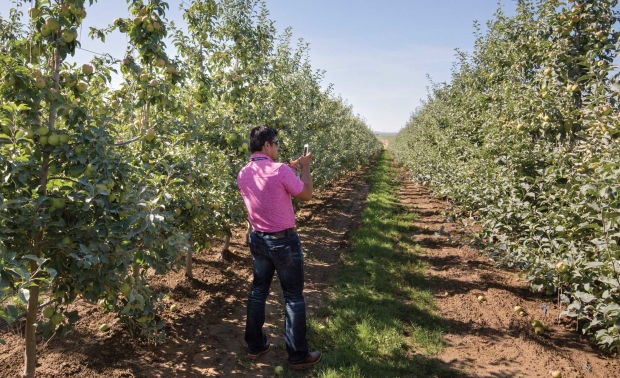
Ramiro Avilez takes photos of Honeycrisp before thinning at the Saddle Mountain West Stemilt block on the first day of the IFTA Washington tour on July 15, 2015. (TJ Mullinax/Good Fruit Grower)
Stemilt Ag Services, which has orchards at Othello in Washington’s Columbia Basin, has found advantages to having row crop farmers as neighbors.
When an orchard is removed, row crops are planted for a couple of years in order to improve the soil and mitigate replant disease.
For example, at its Saddle Mountain West orchard, Stemilt took out four blocks of old Golden Delicious trees in 2010. Dale Goldy, assistant general manager, said the trees were vigorous and out of control, and not producing quality fruit, so the company decided that the best option was to remove them, rather than try to rehabilitate the orchard.

Dale Goldy on the first day of the IFTA Washington tour on July 15, 2015. (TJ Mullinax/Good Fruit Grower)
The ground was cultivated to row crops, such as wheat and beans, for one to three years before replanting to Honeycrisp and Fuji.
“That’s been a real benefit of these plantings—being able to take the time and having neighbors in this area who are willing to farm them, because we’re not row crop people,” said Goldy, who picked up the idea from contacts in Michigan, where the practice is common.
However, in Washington’s Columbia Basin, where farmers typically grow crops in 130-acre circles, he’s found it can be difficult to find someone willing to farm a 25-acre block with wheel lines.
The trees in the replanted blocks are planted on a 4-by-12-foot spacing and trained to a tall spindle system. The Honeycrisp are on Bud 118 rootstock and Fuji are on Pajam 2.
Goldy said he first saw Honeycrisp trees on B.118 about six or eight years ago and liked the look of them, despite it being considered a semi-dwarfing rootstock. Biennial bearing can be a problem, but that’s addressed by cluster thinning at tight cluster stage, he said.
“That forces resting spurs into the system before bloom. That’s helped predispose the tree to have 50 percent resting spurs before we start the season.”
Fuji

Jamie Jamison
Jamie Jamison, Stemilt’s regional manager for Mattawa and Othello, said that in the first replanted Fuji block, the company was taken by surprise by how well the trees grew after the land had been row cropped. The ground was fumigated before the trees were planted.
At planting, the side limbs were cut back to two buds. The limbs that grew ended up being four or five feet long and a half to three-quarters of an inch in diameter after the first season but with little branching.
So, the following year, they were cut back again to two buds and grew into the kind of feathered branches Jamison wanted.
“So we actually lost a year of production by growing the trees too hard,” Jamison said, adding that in hindsight they would have applied less fertilizer.
Recognizing the problem, when they planted another 40 acres of Fuji the following year, they cut the fertilizer and ended up with much less blank wood and had a crop in the third year rather than the fourth.
Asked if he would consider using a less vigorous rootstock, Jamison said he would not because his aim with Fuji is to fill the space by the second year and crop in the third year.
“We just need to learn how to manage the growth at the end of the second season,” he said.
Blind wood
Jamison said they’ve tried a number of ways to overcome blind wood in Fuji trees, including delayed heading one to two weeks after bloom, scoring, and applications of the growth regulator MaxCel (6-benzyladenine) either with paint or as a spray.
MaxCel has produced inconsistent results. Scoring, without MaxCel, has been more consistent. But Jamison said the best solution he’s seen is to wrap, or braid, a one-year-old vertical side shoot around the blind area of the central leader, fastening the end with tape.
This is wood that would otherwise be pruned off. Being of smaller caliper, the shoot will tend to throw dards and buds the year after treatment, which is done in the spring or summer.
Jamison said the idea is not to graft the wood together, but simply to create new branches and fruiting surface in the area of the blind wood. •
Good Fruit Grower’s coverage of the IFTA Washington State study tour continues next month in our October issue.






Leave A Comment